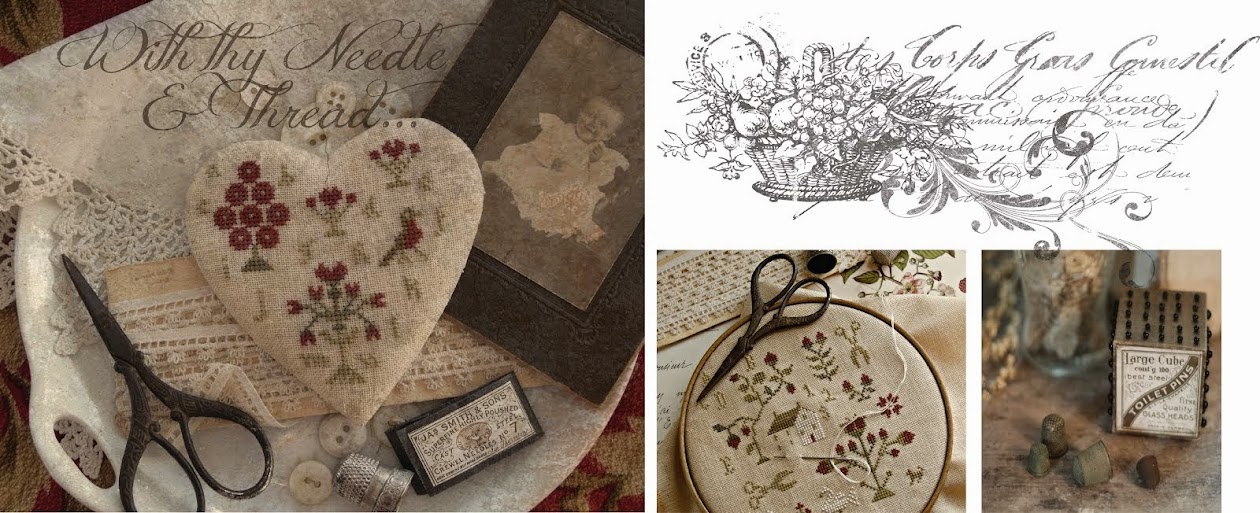The Lesson #1 of the
Summer Schoolhouse ~ Lessons in Abecedarian has released and they are on their way to your local needlework shops, as I type.
I thought I would share the story behind this series,
my inspiration...
The conception for the idea for the Summer Schoolhouse ~ Lessons in Abecedarian lies within the pages of this little old book from the 1940's.
The books title is,
A Little Pretty Pocket-Book.
The books title is,
A Little Pretty Pocket-Book.
It was the size of this book that intrigued me. It is tiny, it would fit in a pocket of a child's dress or britches. I tend to love miniature things! It is the small things in life that I gravitate towards. I found this little book while antiquing. It was calling me, I had to pick it up and see what was inside this tiny book, a book with no title on it's cover page...
I opened it up and began to read.
It reads...
It reads...
Intended for the instruction and amusement of Little Master Tommy, and Pretty Miss Polly...and so on.
Then I read this...A ball and pincushion: the use of which will infallibly make Tommy a good boy and Polly a good girl. A pincushion? Did I just read pincushion? My heart may have skipped a beat!
Then I read this...A ball and pincushion: the use of which will infallibly make Tommy a good boy and Polly a good girl. A pincushion? Did I just read pincushion? My heart may have skipped a beat!
I needed to learn more about this little old book that talks of a pincushion. I began to do some research. The original book was written in 1770, in London, by John Newbery, a prominent publisher of children's books. The book was considered to be the first book specifically directed at children. Hold onto your britches & garter straps, my findings are about to get good! The book was originally sold with free gifts. Free gifts? A ball for a boy and a pincushion for a girl. How cool is that? I want to learn what the pincushion looked like, don't you??!! To date, I haven't located any photos of the pincushion. The original book was black on one side and red on the other and good deeds were to be marked by a pin stuck on the red side and bad ones by a pin in the black.
The book is noteworthy for containing the first documented use of the word "baseball'.
It is the oldest children's book in the Library of Congress collection and is considered to be the first children's book in print. If you happen to visit the Library of Congress, look this tiny book up!
My little book is a facsimile of the original which was issued by F.G. Melcher on the 10th of June, 1944, on the 200th anniversary of the book's first appearance. The first American edition was published by Isaiah Thomas at Worcester, Massachusetts in 1744. I wonder why the American publisher didn't go with the red and black cover as the original?
As you read, you will note the use of the letter f and double f's in place of the s, this is characteristic of 18th century handwriting. Upper case letters were used to begin nouns as well as begin sentences. The lower case s was written in long s (elongated form), at the beginning of a word, in the middle of a word, and written twice. The elongated s can be mistaken for an f.
Little rhyming stories for the letters of the alphabet fill the pages of this tiny book. They read...Great A,B and C and tumble down D, the cat's a blind buff, and she cannot see. Great E, F, and G come here follow me, and we will jump over the Rosemary Tree. It was these pages that got my creative juices flowing. Wouldn't it be fun to do a series around the alphabet? Learning the letters and stitching have long been associated, why not?
There are 4 stories about the seasons in the book. I decided I would base the series on a season and chose summer. The motifs on all the projects are summer-themed. The series released on the first day of summer, with the last of the series to finish at summers-end. Maybe there will be a future series with stitched motifs that pertain to the the other 3 seasons...

I charted the alphabet to look similar to the alphabet font used in the pocket book. Since the book is so small I wanted the Summer Schoolhouse series to be small, or tiny work ~ as I call it The series is meant to be worked over 1 thread on 28 count fabric. Many of you stitchers have emailed me just to let me know this is will be your first experience at working over 1. Just like a student, learning something new...that's great! Stitching over 1 thread on 28 count fabric looks more like a painting then stitching, it is extraordinarily wonderful!
Here you can get a perspective how tiny the book is with the use of the thimble and buttons for comparison. The book measures 2 1/2" x 3 3/4".
One chapter is dedicated to rules for behaviour of children....
&
Proverbs for children...
And there you have it.
Inspiration can come from strange places sometimes!
Are you a student of this series? If not, there is still time!
Gather up your "school supplies" and come along!
Gather up your "school supplies" and come along!
Kindly,
Brenda










